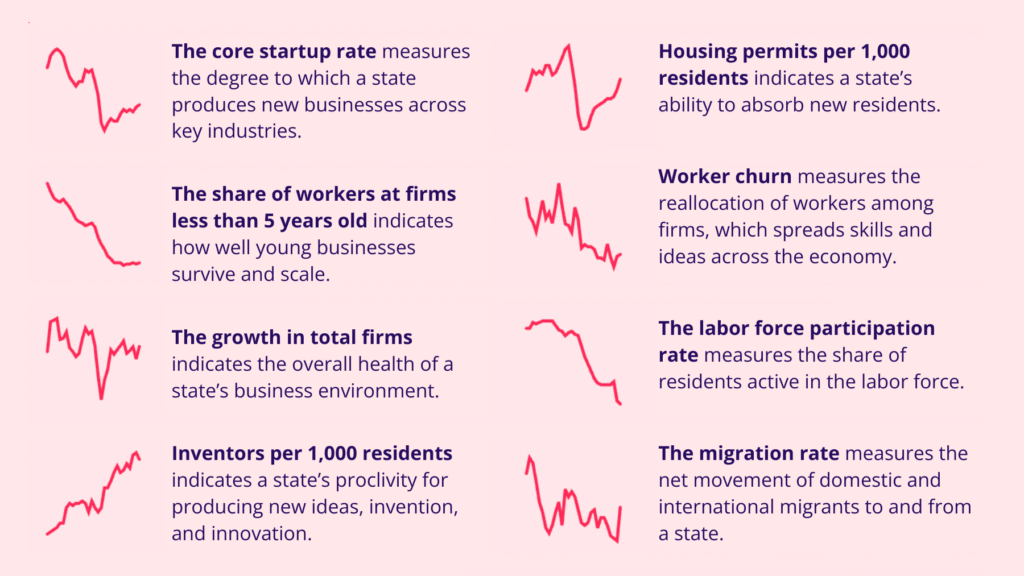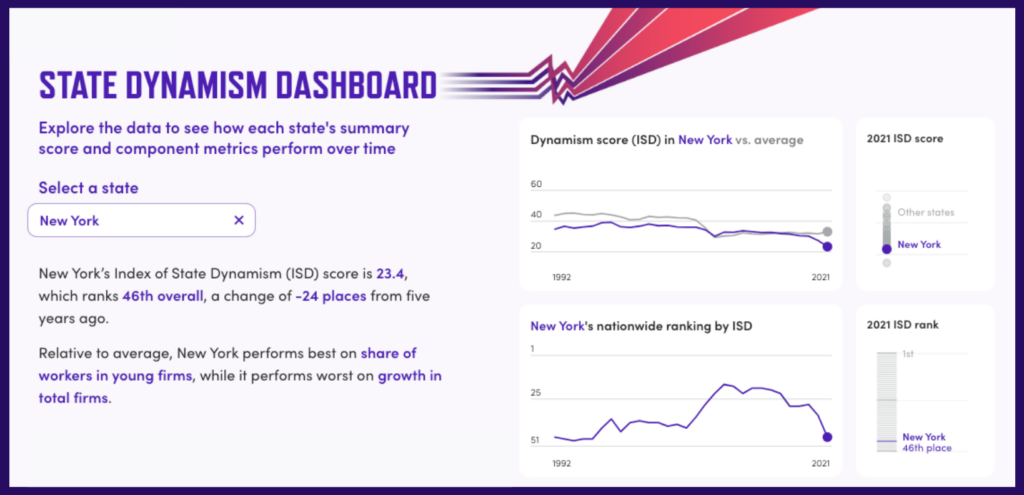by Kenan Fikri and Daniel Newman
No state has suffered as dramatic a reversal of economic fortune in recent years as New York. The pandemic accelerated a decade-long decline that saw the state relinquish a quarter-century’s worth of improvement on EIG’s Index of State Dynamism (ISD), a comprehensive gauge of the underlying strength and vitality of state economies.
New York’s troubles stand out among big states nationwide, and they matter inordinately because of the state’s economic significance. With the country’s third largest GDP, New York is one of the United States’ most formidable economic engines. When it suffers, the whole country underperforms.
This is a moment of both urgency and opportunity for the state: urgency because of the precipitousness of the state’s fall, and opportunity because of the many levers the state can pull to restore dynamism, if it so chooses.
The Rise and the Fall
The Empire State, home to the nation’s quintessential “superstar city,” was one of the first out of the gate in the recovery from the Great Recession. New York City thrived as educated millennials flocked to knowledge economy jobs, and big cities nationwide enjoyed a resurgence. The state’s economic fortitude powered a rapid ascent up the rankings on the ISD, climbing 24 spots to 17th place between 2006 and 2010.
But no sooner did the state peak than its decline commenced. The slow but steady economic recovery from the global financial crisis picked up steam across the rest of the country, and by 2017, New York’s rank had fallen back to 29th as other relatively better-performing states pulled ahead.
The state’s dynamism score fell to an all-time low in 2021—a year when most states saw meaningful upticks and the average state dynamism score reached a 13-year high. That pushed the state further down the rankings to 46th, New York’s lowest position since the mid-1990s. The nation’s third-largest economy had once again become one of its least dynamic.
Not only do New York’s dynamism doldrums represent a complete reversal of the relative progress it made over the past 25 years, but the state’s poor performance stands out among its peers. All of the country’s other large state economies rank much higher: California (11th), Texas (7th), and Florida (5th). California’s cities have famously suffered during the pandemic just like New York’s, but the Golden State fell only six places, from 5th in 2020 to 11th in 2021. California’s dynamism score remains well above its all-time lows registered during the Great Recession, too. Texas has maintained a stable ranking for years. Pandemic-era tailwinds pushed Florida seven places out of its recent slump, solidly back into the top 10.
Diagnosing New York’s Decline
The ISD combines eight indicators into a single measure of economic dynamism, and New York trails the national average on most. Breaking out the component measures illuminates which factors contribute most to the state’s poor performance. They can be separated into nearer-term and longer-term factors.
Several of the near-term drivers include:
- A pandemic-era spike in business closures: Business closures across the state were high while the core startup rate was below the national average. Nearly 12,800 businesses closed statewide in 2021, equivalent to an overall drop of 3.2 percent—the second-largest decline among states. Just a decade prior, New York had been in the top five states with the highest growth in firms, reflecting the state’s relative resilience in the aftermath of the Great Recession. The post-pandemic weakness wasn’t limited just to Manhattan, either. More firms closed than opened in every one of the state’s metropolitan areas.
- Fading entrepreneurial edge: For nearly 10 years, New York posted a significantly above-average startup rate across its core industry sectors, one of the state’s dynamism strengths throughout the 2010s. The positive run ended in 2021, however, when New York’s core startup rate fell below the national average to an all-time low. In other words, not only were unprecedented numbers of businesses closing, but fewer were starting, too. The state was the only one to see its core startup rate reach an all-time low in 2021.
- The worst migration rate in the country: Just over 267,000 more people moved out of New York than moved in from other states or abroad, sapping the state’s economy of vital human capital. As a result, the state lost 1.3 percent of its prior year’s population—the worst performance of any state in 2021. Even as international migration remained positive, the exodus of domestic migrants to other states far exceeded the number of new arrivals from abroad. The spike in outmigration means that much of the state’s population gain in the decade prior has since disappeared, shrinking the state’s total population back below 20 million.
Some long-term factors behind the state’s malaise include:
- Inadequate housing construction: New York issued just 2.0 new housing permits for every 1,000 residents in 2021, the fourth lowest rate in the country and well below the national average of 5.1 per 1,000 residents. New York has almost always been among the five worst performing states on housing production stretching back to the start of the ISD in the early 1990s. The lack of relatively affordable housing pushes people to look for places with lower cost of living, not only in neighboring states but increasingly across the Sun Belt in places like Florida.
- Middling innovation: In the early 1990s, the number of inventors in New York on a per capita basis was consistently above the national average—the state’s only ISD component to score so. But that advantage has dwindled in the intervening years, with the state dropping in the ranking on this measure of innovation from 11th to 18th and only just exceeding the country overall. New York is now far from an innovation leader. California is home to nearly three three times as many inventors per capita (1,000 residents), and neighboring Connecticut nearly twice as many. While the state’s growing semiconductor clusters upstate are likely to receive a further boost from federal funding, this nascent sector has yet to move the needle on state patenting figures.
- Low labor force participation: The share of the state’s over-16 population either employed or actively seeking employment was just over 59 percent in 2021, well below the national average and up only slightly from the state’s all-time low in 2020. New York has perennially lagged the nation on this measure of labor market health and stands just ahead of Florida, only without the retirees.
Stepping back from the ISD itself, New York’s malaise is visible across a number of additional economic indicators. Most notably, the state is shedding its most economically valuable workers at an alarming rate, with the number of people in their prime working years (ages 25-54) falling by 5 percent from 2012 to 2022. That shrinking of the productive workforce touched all but one of the state’s 62 counties. The latest available tax information shows that the state also saw a massive outmigration of highly compensated workers early in the pandemic, accounting for a net loss of $25 billion in taxable income to other states in 2021.
Meanwhile, total employment remains 0.7 percent below pre-covid levels, according to the latest October 2023 data from the Bureau of Labor Statistics. While the New York City metro area has fully recovered all the jobs it lost (and then some, with October 2023 employment 1.4 percent above October 2019 employment), employment is still 2 percent below pre-pandemic levels in Buffalo and Rochester and 5 percent below in Binghamton and Elmira.
Wage and earnings growth has also been subpar: Since the onset of the pandemic, the change in average weekly wages in New York has lagged behind the U.S. overall. Similarly, total personal income in the state grew by just 0.4 percent from Q4 2019-Q4 2021, the third worst result nationally.
Where to Next?
Alone, New York would be the world’s tenth-largest economy. Its health and vitality are of immense national importance. The ISD shows that the state is floundering far more fundamentally than the headlines about the pandemic-era hollowing out of Manhattan suggest on their own. The pandemic hastened the Empire State’s relative decline on the index, humbling the state’s preeminent economic engine (the City) so thoroughly that it laid bare the chronic troubles afflicting the state under the surface. The state’s downward trajectory stands in stark contrast to other economic powerhouses like California, Florida, and Texas.
The ISD doesn’t just diagnose the problem; it shines a light on the path to renewal, too. Many of the levers that foster a dynamic economy are within the state’s control. Housing is a classically local issue; only state and municipal action can make it easier to build so New York communities can adequately attract and house the human capital they need to thrive. Similarly, migration rates are functions of an area’s attractiveness, or the value proposition it offers residents: the amenities and quality of life it offers in exchange for the taxes it collects. There is much a state can do to improve the balance between the benefits and costs of living in it, and between the economic opportunities and challenges it offers to households and businesses.
Most immediately, a bill to ban noncompete agreements is currently sitting on Governor Hochul’s desk, awaiting either her signature or her veto. There may be no more direct pro-dynamism, pro-worker policy available, and signing it would signal at a stroke of the pen that the state is committed to renewal through worker mobility, entrepreneurship, and innovation. It would also help the state make the most of the two coveted Tech Hubs designations the state recently received from the U.S. Department of Commerce, as well as the billions in CHIPS Act money for which the state is competing.
Pro-dynamism policies are inherently pro-worker, and the latest figures show that New York has urgent work ahead.
About the Index of State Dynamism
EIG’s Index of State Dynamism (ISD) offers a simple and comprehensive way to understand one of the most important concepts in economics. Dynamism is the process through which an economy renews itself. It captures the underlying rates of churn in the economy—the startup rate, the changing composition of firms, the movement of workers across firms and geographies, and the pace of innovation. Without dynamism, economies trend toward stagnation.
The ISD unpacks the core elements of dynamism to reveal how each state is performing in cultivating the conditions for progress. Explore your state here: https://eig.org/state-dynamism/#explorer









